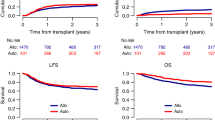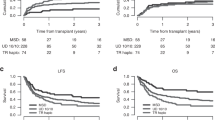Abstract
Core-binding factor acute myeloid leukemia (CBF-AML) generally has a favorable prognosis, with allogeneic hematopoietic stem cell transplantation (allo-SCT) recommended for relapsed/ refractory (R/R) cases achieving second complete remission (CR). However, clinical outcomes remain suboptimal for patients who relapse or fail to achieve CR following induction chemotherapy. Allo-SCT in non-CR is a potential strategy for such patients, though supporting evidence in CBF-AML is limited. To assess outcomes and prognostic factors of allo-SCT in R/R CBF-AML with active disease, we conducted a retrospective analysis of 610 patients with CBF-AML in non-CR undergoing allo-SCT from 2010 to 2021 across 174 centers within the European Society for Blood and Marrow Transplantation. Graft sources included matched sibling (MSD, n = 151), unrelated (UD, n = 368), and haploidentical donors (Haplo, n = 91). Among patients, 124 had inv(16), and 486 had t(8;21). Two-year overall survival (OS) and leukemia-free survival (LFS) were 53.6% and 42.7%, respectively. Haplo-SCT showed inferior OS compared to MSD (HR 1.79, p = 0.003) and UD (HR 1.64, p = 0.004) and reduced chronic graft-versus-host disease. Patients with t(8;21) exhibited higher relapse incidence (HR 2.04, p = 0.002) and poorer survival outcomes than those with inv(16). These findings confirm the therapeutic role of allo-SCT in R/R CBF-AML in non-CR, supporting its favorable risk profile.
This is a preview of subscription content, access via your institution
Access options
Subscribe to this journal
Receive 12 print issues and online access
269,00 € per year
only 22,42 € per issue
Buy this article
- Purchase on SpringerLink
- Instant access to full article PDF
Prices may be subject to local taxes which are calculated during checkout


Similar content being viewed by others
Data availability
Data will be available upon request to the Acute Leukemia Working Party (ALWP) office of the European Society for Blood and Marrow Transplantation (EBMT).
References
Darwish C, Farina K, Tremblay D. The core concepts of core binding factor acute myeloid leukemia: Current considerations for prognosis and treatment. Blood Rev. 2023;62:101117. https://doi.org/10.1016/j.blre.2023.101117.
Ye Y, Labopin M, Gérard S, Yakoub-Agha I, Blau IW, Aljurf M, et al. Lower relapse incidence with haploidentical versus matched sibling or unrelated donor hematopoietic cell transplantation for core-binding factor AML patients in CR2: A study from the Global Committee and the Acute Leukemia Working Party of the European Society for Blood and Marrow Transplantation. Am J Hematol. 2024. https://doi.org/10.1002/ajh.27342.
Halaburda K, Labopin M, Mailhol A, Socié G, Craddock C, Aljurf M, et al. Allogeneic stem cell transplantation in second complete remission for core binding factor acute myeloid leukemia: a study from the Acute Leukemia Working Party of the European Society for Blood and Marrow Transplantation. Haematologica. 2020;105:1723–30. https://doi.org/10.3324/haematol.2019.222810.
Solh M, Yohe S, Weidorf D, Ustun C. Core-binding factor acute myeloid leukemia: heterogeneity, monitoring and therapy. Am J Hematol. 2014;89:1121–31.
Sinha C, Cunningham LC, Liu PP. Core binding factor acute myeloid leukemia: new prognostic categories and therapeutic opportunities. Semin Hematol. 2015;52:215–22.
Al-Harbi S, Aljurf M, Mohty M, Almohareb F, Ahmed SOA. An update on the molecular pathogenesis and potential therapeutic targeting of AML with t(8;21)(q22;q22.1);RUNX1-RUNX1T1. Blood Adv. 2020;4:229–38.
Döhner H, Estey E, Grimwade D. Diagnosis and management of AML in adults: 2017 ELN recommendations from an international expert panel. Blood. 2017;129:424–47. https://doi.org/10.1182/blood-2016-08-733196.
Appelbaum FR, Kopecky KJ, Tallman MS. The clinical spectrum of adult acute myeloid leukaemia associated with core binding factor translocations. Br J Haeamtol. 2006;135:165–73.
Brissot E, Labopin M, Ehninger G, Stelljes M, Brecht A, Ganser A, et al. Haploidentical versus unrelated allogeneic stem cell transplantation for relapsed/refractory acute myeloid leukemia: a report on 1578 patients from the Acute Leukemia Working Party of the EBMT. Haematologica. 2019;104:524–32. https://doi.org/10.3324/haematol.2017.187450.
Maffini E, Labopin M, Kröger N, Finke J, Stelljes M, Schroeder T et al. Allogeneic hematopoietic cell transplantation for older patients with AML with active disease. A study from the Acute Leukemia Working Party of the European Society for Blood and Marrow Transplantation (EBMT). Bone Marrow Transplant. 2024. https://doi.org/10.1038/s41409-024-02275-6.
Duval M, Klein JP, He W. Hematopoietic stem-cell transplantation for acute leukemia in relapse or primary induction failure. J Clin Oncol. 2010;28:3730–8. https://doi.org/10.1200/JCO.2010.28.8852.
Nagler A, Savani BN, Labopin M. Outcomes after use of two standard ablative regimens in patients with refractory acute myeloid leukaemia: a retrospective, multicentre, registry analysis. Lancet Haematol. 2015;2:e384–392.
Gyurkocza B, Lazarus HM, Giralt S. Allogeneic hematopoietic cell transplantation in patients with AML not achieving remission: potentially curative therapy. Bone Marrow Transplant. 2017;52:1083–90.
Jabbour E, Daver N, Champlin R, Mathisen M, Oran B, Ciurea S, et al. Allogeneic stem cell transplantation as initial salvage for patients with acute myeloid leukemia refractory to high-dose cytarabine-based induction chemotherapy. Am J Hematol. 2014;89:395–8.
Brissot E, Labopin M, Stelljes M. Comparison of matched sibling donors versus unrelated donors in allogeneic stem cell transplantation for primary refractory acute myeloid leukemia: a study on behalf of the Acute Leukemia Working Party of the EBMT. J Hematol Oncol. 2017;10:130.
Craddock C, Labopin M, Pillai S. Factors predicting outcome after unrelated donor stem cell transplantation in primary refractory acute myeloid leukaemia. Leukemia. 2011;25:808–13. https://doi.org/10.1038/leu.2011.13.
Bacigalupo A, Ballen K, Rizzo D, Giralt S, Lazarus H, Ho V, et al. Defining the intensity of conditioning regimens: working definitions. Biol Blood Marrow Transplant. 2009;15:1628–33.
Harris AC, Young R, Devine S, Hogan WJ, Ayuk F, Bunworasate U, et al. International, multicenter standardization of acute graft-versus-host disease clinical data collection: a report from the Mount Sinai acute GVHD international consortium. Biol Blood Marrow Transplant. 2016;22:4–10.
Jagasia MH, Greinix HT, Arora M, Williams KM, Wolff D, Cowen EW, et al. National Institutes of Health consensus development project on criteria for clinical trials in chronic graft-versus-host disease: I. The 2014 diagnosis and staging working group report. Biol Blood Marrow Transplant. 2015;21:389–401.e381.
Ruggeri A, Labopin M, Ciceri F, Mohty M, Nagler A. Definition of GvHD-free, relapse-free survival for registry-based studies: an ALWP-EBMT analysis on patients with AML in remission. Bone Marrow Transplant. 2016;51:610–1.
Döhner H, Wei AH, Appelbaum FR, Craddock C, DiNardo CD, Dombret H, et al. Diagnosis and management of AML in adults: 2022 recommendations from an international expert panel on behalf of the ELN. Blood. 2022;140:1345–77. https://doi.org/10.1182/blood.2022016867.
Brunner A, Blonquist T, Sadrzadeh H, Perry A, Attar E, Amrein P, et al. Population-based disparities in survival among patients with Core-binding factor acute myeloid leukemia: a SEER database analysis. Leuk Res. 2014;38:773–80.
Tazi Y, Arango-Ossa JE, Zhou Y, Bernard E, Thomas I, Gilkes A, et al. Unified classification and risk-stratification in acute myeloid leukemia. Nat Commun. 2022;13:4622.
Wang Y, Wu DP, Liu QF, Qin YZ, Wang JB, Xu LP, et al. In adults with t(8;21)AML, posttransplant RUNX1/RUNX1T1-based MRD monitoring, rather than c-KIT mutations, allows further risk stratification. Blood. 2014;124:1880–6.
Hospital MA, Prebet T, Bertoli S, Thomas X, Tavernier E, Braun T, et al. Core binding factor acute myeloid leukemia in first relapse: a retrospective study from the French AML intergroup. Blood. 2014;124:1312–1319.17.
Burnett AK, Goldstone A, Hills RK, Milligan D, Prentice A, Yin J, et al. Curability of patients with acute myeloid leukemia who did not undergo transplanta tion in first remission. J Clin Oncol. 2013;31:1293–301.
Thol F, Schlenk RF, Heuser M, Ganser A. How I treat refractory and early relapsed acute myeloid leukemia. Blood. 2015;126:319–27.
Yanada M, Yamasaki S, Kondo T, Kawata T, Harada K, Uchida N, et al. Allogeneic hematopoietic cell transplantation for patients with acute myeloid leukemia not in remission. Leukemia. 2024;38:513–20.
Cairoli R, Beghini A, Grillo G, Nadali G, Elice F, Ripamonti CB, et al. Prognostic impact of c-KIT mutations in core binding factor leukemias: an Italian retrospective study. Blood. 2006;107:3463–8.
Author information
Authors and Affiliations
Contributions
ST, EB and MM designed the study. ML performed the statistical analysis. ST wrote the manuscript. EB and MM revised the manuscript. RZ, MS, TS, NK, WB, JP, MB, CS, JT, ME, JE, AN, MM, and FC were the principal investigators at the centers recruiting the highest number of patients for the study and contributed key clinical data. All authors were involved in manuscript preparation and approved the final version.
Corresponding author
Ethics declarations
Competing interests
The authors declare no competing interests.
Ethics approval and consent to participate
The study was approved by the Institutional Review Board of the ALWP of the EBMT and complied with country-specific regulatory requirements. All methods involving human participants were carried out in accordance with the ethical standards of the institutional and national research committee and with the 1964 Helsinki Declaration and its later amendments. Patients provide informed consent authorizing the use of their personal information for research purposes.
Additional information
Publisher’s note Springer Nature remains neutral with regard to jurisdictional claims in published maps and institutional affiliations.
Supplementary information
Rights and permissions
Springer Nature or its licensor (e.g. a society or other partner) holds exclusive rights to this article under a publishing agreement with the author(s) or other rightsholder(s); author self-archiving of the accepted manuscript version of this article is solely governed by the terms of such publishing agreement and applicable law.
About this article
Cite this article
Tarantino, S., Labopin, M., Zeiser, R. et al. Allogeneic stem cell transplantation in de novo core-binding factor acute myeloid leukemia in active disease: a study from the Acute Leukemia Working Party of the European Society for Blood and Marrow Transplantation. Bone Marrow Transplant (2025). https://doi.org/10.1038/s41409-025-02596-0
Received:
Revised:
Accepted:
Published:
DOI: https://doi.org/10.1038/s41409-025-02596-0



